Medical Waste Disposal & Management Services
Our medical waste disposal services include:
Pick Up Schedule Based on Customer Needs | All Bio Boxes, Red Bags, and Labels | Guidance On Compliance Needs | Document Sterilization, Transfer and Disposal
*Free Sharps Container with Bundle Option
Go Green Medical Waste Disposal; Simple Billing & Never any Hidden Fees or Fluctuating Charges!
Medical Waste Management Services
Go Green Solutions will assist you with any medical waste you generate. When it comes to managing the bio-medical waste streams generated by your facility, your company has certain requirements. From medical waste disposal to document destruction, Go Green Solutions is the industry leader in cost-effective bio medical waste management solutions.
Any material that comes into contact with bodily fluids is classed as medical waste. It is defined as any solid waste generated during human diagnosis, treatment, or immunization. In the past, this type of waste was collected in specific bags and plastic boxes in clinical settings and then discarded like regular garbage. However, it was immediately discovered that this technique might spread illnesses and viruses, potentially causing outbreaks.
Sharps, needles, and IV catheters that contain any human blood or body fluid are now properly removed using the red biohazardous containers and bags visible throughout hospitals and doctors’ offices. Paper towels, wipes, gloves, syringes without needles, bandages or dressings containing minute amounts of dry blood or fluid, and any other medical waste are all considered medical waste. Syringes containing needles or sharp things that can pierce a plastic bag need to be stored in a specific container for extra protection.
What You Need TO Know Before Signing On With A Medical Waste Management Service Company...
Before signing on with a Bio Medical Waste Management Company, there are many questions that should be asked! See below for some helpful questions so you don’t get stuck with a Sharps Disposal Company that is over-priced, has un-ethical contracts, or doesn’t show up!
Sharps Disposal Companies have expanded over the years, so there are many choices. However, they’re not all built the same way. Some companies have high quality customer service and offer the necessary compliance training to keep you and your employees safe while others just don’t show up at all. Last, there are Bio Medical Waste Management companies that charge high fees with hidden costs, while others can cut the cost between 20%-50% and even higher.
The list of questions below is a MUST before making an agreement:
What is the experience level of the company? History is important in any company – even a sharps disposal company!
- What system is used for routes?
- Is Compliance Training offered?
- Is the Company 100% Compliant?
- How effectively do they communicate?
Does the company seem open to working with you?
- Not all needs are the same. Some Bio Medical Waste Management companies need flexible scheduling or have specific pick up requests. It is important to find a company that is willing and open to discussing the specific needs of your company; a sharps disposal company willing to tailor to your needs!
Do they have simple billing?
- It is crucial to find out how you will be charged – before you sign up! Medical Waste Management Service companies can have a significant difference in fees when it comes to medical waste disposal. Check and make sure there are never any hidden fees or fuel charges.
Do they have a Compliance Officer | Customer Advocate?
- Some Bio Medical Waste Management companies have no level of support. It is important that the company you sign on with has someone that can walk you through compliance training as well as support you through the process of how their companies works and anything else you need support with.
d
Questioning what you can put into the red bag? Or, better yet – where you can purchase sharps containers? See some resources below that will help you!
Have Questions?
Try searching for your answers!
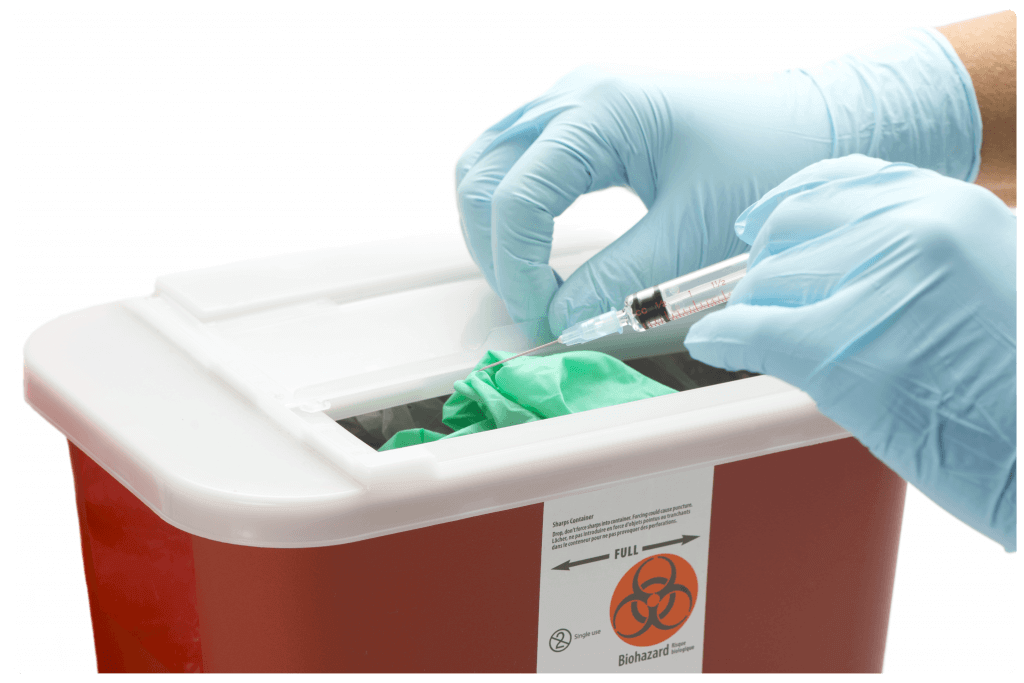
Sharps Disposal
Sharps disposal can be a difficult task. A single needle stick can result in death or thousands of dollars in fines from the EPA or other regulatory agencies. To make matters worse, regulations are always changing and might differ significantly across state or even local lines.
It’s common to “err on the side of caution.” Unfortunately, this can result in costs ballooning out of control.
What is the “sweet spot” for disposing of sharps? Knowledge is truly power in the trash disposal industry.
“Any object that can cut or penetrate the skin” is how sharps are defined. In the medical realm, there’s also the possibility of bloodborne pathogen infection. Sharps disposal is a top priority in any healthcare facility since this combination can spread disease.
Sharps Disposal & Safety
See our Compliance Solution Below!
Review the list from the NIH to read many principles on how to safely dispose of sharps.
All staff employed at Healthcare facilities should follow guidelines for handling sharps safely when disposing of them. Safety first! Follow these steps below:
- Handle Sharps as little as possible.
- Promptly Discard (approved sharps container)
- Fill sharps containers only to the “fill line”
- Close when not being uses
- Keep in room away from the public
Read below for a more descriptive overview:
Sharps Safety When Handling
- Do not pass sharps from hand to hand.
- Used needles cannot be bent or broken before disposal.
- Used sharps must immediately be discarded promptly into a sharps container.
Sharps Containers:
- Must be kept in a space that avoids spillage.
- Must be kept at a height that allows for safe disposal of sharps.
- Must be kept away from the public.
- Must be filled only to “fill line”.
- Once full, must be disposed of.
- Should be closed between uses.
- Must only be used for sharps.
- Should be disposed of after 3 months even when not full.
Biohazard Waste Categories
Solid Waste
Non-sharp goods contaminated with bodily fluids or biological material are included. Gloves, pipettes, cloths, or culture, for example.
Liquid Waste
Contains large amounts of blood or body fluids.
Sharps Waste
Any material that can pierce or puncture skin and is contaminated with biological material that poses a risk of transmission or release to the environment is included. Needles, syringes, scalpels, microscopic slides, broken glass, and tubes, for example.
Methods of Sharps Disposal
All sharps should be placed in a dedicated sharps disposal container, according to the FDA. After then, we can help with the collection method of sharps disposal.
We provide collection services. Packaging medical waste on-site is a great option for sharps disposal. After that, we come to collect it and transport it to a treatment facility.
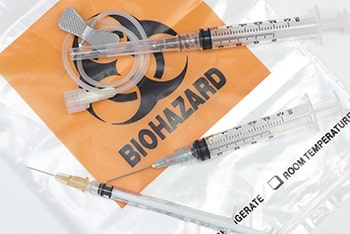
Here are some instances of sharps that need to be disposed of differently in a sharps container:
- Needles. For injecting drugs, hollow needles are utilized.
- Syringes. The body of a “plunger” was used to inject narcotics. It’s possible that a needle is attached.
- Sets for infusion. Medication is delivered beneath the skin via tubing/needle devices.
- Sharp plastics may necessitate special handling
- Epi-pens are used to treat allergic reactions. In case of anaphylactic shock, auto injectors with epinephrine are pre-filled.
- Insulin Pens. Auto-injectors pre-filled with insulin for diabetics.
- Connection Needles / Connection Sets. Tube-to-needle connections. Patients on hemodialysis at home are mostly served by this device.
- Blades such as scalpels and other blades.
- Scissors are a type of knife that can be used to cut flesh or dressings.
- Glass. Sharps disposal may be required even if the glass is neither broken or contaminated.
- Lancets. AKA “fingerstick” devices. These short, double-edged blades are used to get blood drops for testing. (Think, “diabetes blood test prick.”)
Why Is Sharps Disposal Important?
Sharps disposal, according to the National Institutes of Health, can help prevent the transmission of infectious bloodborne infections.
According to statistics, sharps account for 16 percent of all occupational injuries in hospitals.
Sharps injuries greatly increase the risk of infections like Hepatitis B, Hepatitis C, and HIV in hospital personnel.
Sharps disposal that is done properly prevents or considerably decreases the danger of infection and sticks.
Sharps disposal that isn’t done properly might result in significant fines.

Industry Standards for Sharps Disposal
The National Institutes of Health has outlined many guidelines for disposing of sharps safely.
The complete list may be seen here.
Sharps handling and disposal should be done according to best practices by healthcare personnel. Handling sharps as little as possible and immediately disposing them in a puncture-resistant, sealed container are important principles to follow.
Sharps containers are protected by a number of safe handling guidelines. Containers should only be filled to the “fill line,” closed between usage, and kept out of the public’s reach.

Best Handling Practices
- Sharps should never be handed from one person to the next.
- Before discarding used needles, they must not be fractured or bent.
- Sharps must be disposed of immediately in a sharps container.
- To avoid leakage, it must be located.
Sharps Containers
- Once full, it must be discarded.
- It must be stored at a height that allows for the safe disposal of sharps.
- Between usage, the container should be closed.
- It must be kept out of sight of the general population.
- It cannot be used for anything other than the disposal of sharps.
- It can’t be overstuffed.
- Even if the container isn’t completely empty, it should be discarded after three months.
Violations of Sharps
Even a small practice might be fined $70,000 or more for a sharps violation. OSHA, the EPA, or other national or local government agencies can levy fines. Almost all sharps offenses can be avoided. It only takes a little information to get started.
Some of the most common sharps disposal infractions are listed below:
- Sharps disposal in non-compliant containers. Milk bottles, water bottles, glass bottles, and soda cans are examples of non-compliant containers. All of these are easily punctured or broken.
- Sharps shouldn’t be disposed of in the usual trash. Employees and members of the public are exposed to needle sticks as a result of this practice. Biohazards are also introduced into landfills.
- Before discarding needles, bending or shattering them. Some people believe that doing so reduces the likelihood of needle sticking. In fact, it has been discovered that it increases the risk.
- Sharps containers that have been improperly sealed. Sharps containers must be tightly sealed to avoid spillage and the squeezing out of sharps under pressure.
- Containers that have been labeled incorrectly. Sharps must be labeled as biohazardous sharps and kept in bright red, puncture-resistant containers.
- Putting sharps in the wrong container is a common mistake. Sharps should never be thrown away.
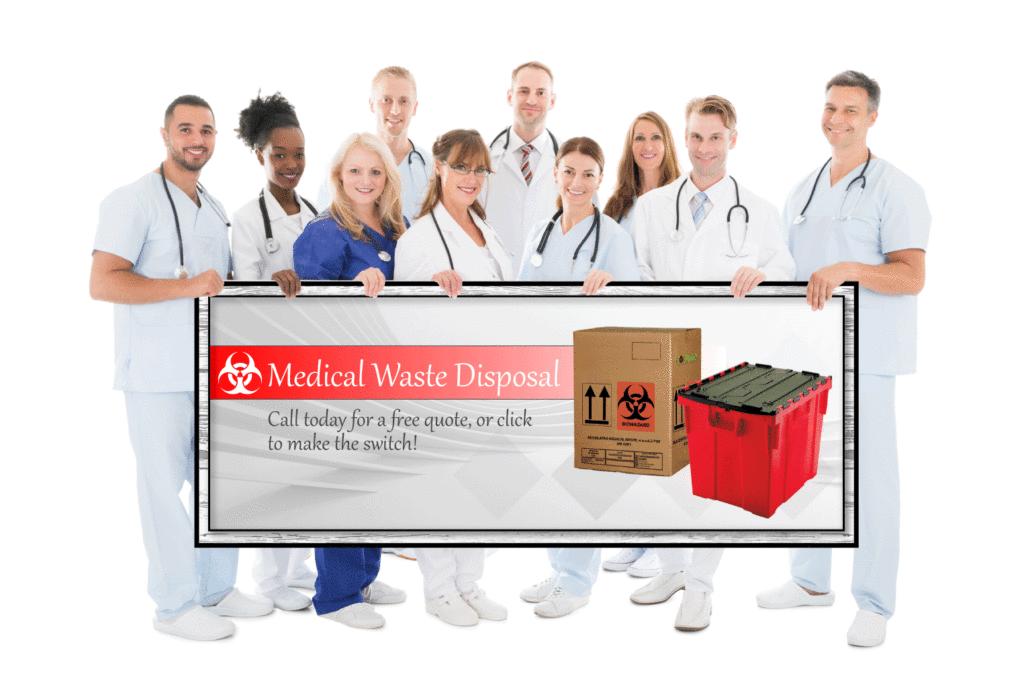
You Got Stuck By A Needle - Now What?
A bloodborne pathogen can enter your body through a needle stick from a sharp. Sticks, on the other hand, do not always imply infection. If you’re hurt by a sharp, you have a plan to fall back on.
The CDC recommends that if you get a needle stick or a cut from a sharp, you do the following steps right away:
1) Use soap and water to clean the cut/needlestick.
2) Rinse any water that has splashed on your skin, mouth, or nose.
3) Rinse the eyes with saline, sterile irrigants, or clean water if they are contaminated.
4) Inform a supervisor about the needlestick or cut.
5) Seek medical help right away.
What is Medical Waste? Full Overview
Medical Waste Disposal
Medical Waste Disposal is one of the most difficult difficulties that healthcare workers encounter on a daily basis. Other issues, including as HIPAA, epidemiology, potential civil action, and state and municipal regulation, can make it more difficult. We’re looking at the fundamental principles around medical waste because at Go Green Solutions, we want to help providers become better providers.
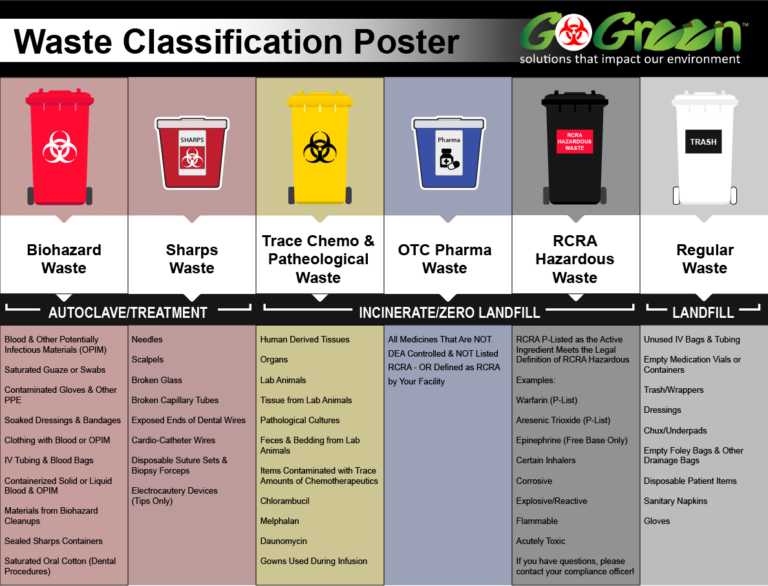
Medical Waste Definition
Medical Waste is defined as any trash that contains infectious (or possibly infectious) substances. Waste generated by healthcare facilities such as physician’s offices, hospitals, dentistry practices, laboratories, medical research facilities, and veterinary clinics is included in this definition. This includes the following:
- Anything drenched in blood should be avoided (gloves, gauze, gowns, etc.)
- During treatments, human or animal tissue that is generated.
- Infectious-disease and-agent cultures
- Any garbage generated in the rooms of patients suffering from contagious diseases.
- Vaccines that have been tossed out
Medical waste may contain bodily fluids, such as blood, as well as other pollutants. The Medical Waste Tracking Act of 1988 classified it as waste generated during human or animal medical research, testing, diagnosis, immunization, or treatment. Culture dishes, glassware, bandages, gloves, discarded sharps such as needles or scalpels, swabs, and tissue are just a few examples.
Did you know? Medical Waste Can Be Described Using Different Names
- Biomedical Waste
- Healthcare Waste
- Infectious Medical Waste
- Regulated Medical Waste, or, RMW
- Clinical Waste
- Biohazardous or Biohazard Waste
Although the phrases are sometimes interchanged, there is a difference between ordinary healthcare waste and hazardous medical waste. Sharps, human tissue, fluids, and contaminated supplies are classified as “biohazardous,” while non-contaminated equipment and animal tissue are classified as “generic medical waste” by the WHO.
In fact, medical waste includes office paper, sweeping garbage, and cooking waste from healthcare facilities, even though it isn’t regulated and isn’t harmful in nature.
Types of Medical Waste Produced
-
Sharps. Anything that can puncture the skin, such as needles, scalpels, lancets, broken glass, razors, ampules, staples, cables, and trocars, falls into this category.
-
Contaminated Waste. This category includes swabs, tissues, excreta, equipment, and lab cultures, as well as everything infectious or potentially contagious.
-
Radioactive. This type of trash usually refers to unneeded radiation or laboratory research liquid. Any glassware or other items contaminated with this liquid can also be included.
-
Pathological. This trash includes human fluids, tissue, blood, body parts, bodily fluids, and contaminated animal carcasses.
-
Pharmaceuticals. All unused, expired, and/or contaminated vaccinations and medications are grouped together in this category. Antibiotics, injectables, and tablets are also included.
-
Chemical. Disinfectants, laboratory solvents, batteries, and heavy metals from medical equipment, such as mercury from damaged thermometers, are examples.
-
Waste that is genotoxic. This is a type of medical waste that is carcinogenic, teratogenic, or mutagenic in nature. It can include cytotoxic medications that are used to treat cancer.
Non-Regulated Medical Waste.This form of garbage, also known as non-hazardous waste, poses no special chemical, biological, physical, or radioactive risk.
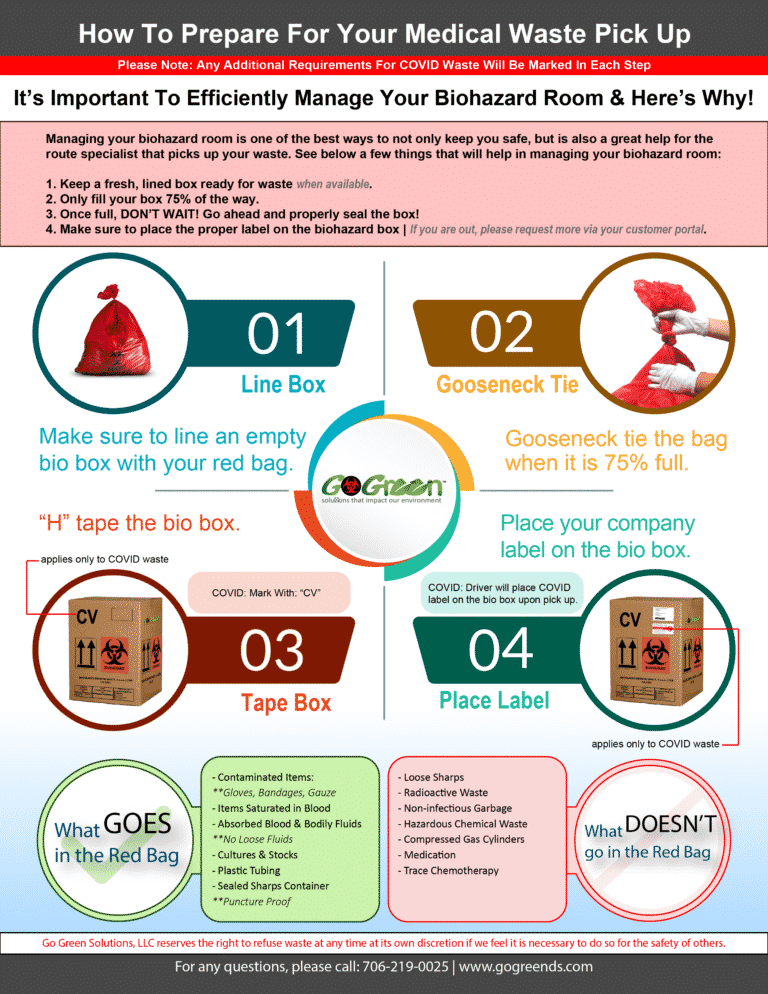
What Happens After My Medical Waste Pick Up? How is Medical Waste Disposed Of?
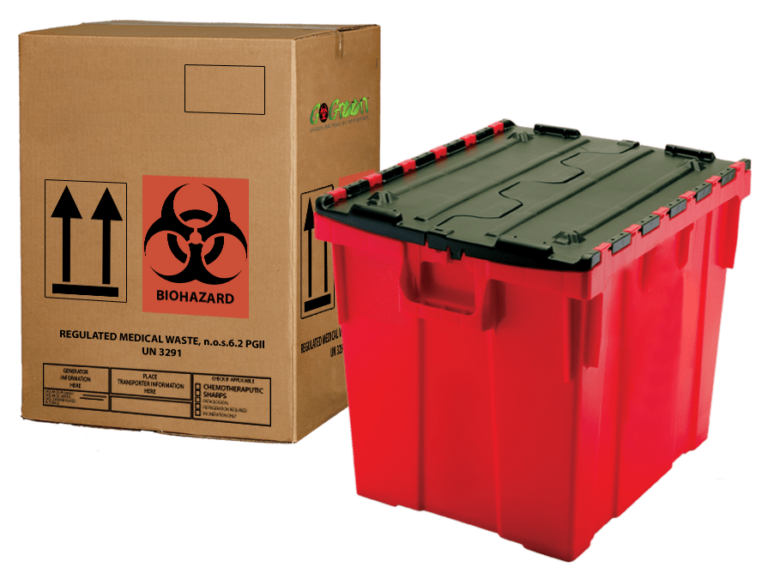
Exposure Control Plan – Every employer with an employee(s) subjected to occupational exposure as defined by CFR 29 1910.1030 must develop a written Exposure Control Plan to eliminate or reduce employee exposure.
Methods of Compliance – To avoid contact with blood or other potentially infectious materials, universal precautions must be maintained. When distinguishing between distinct types of human fluids is difficult or impossible, all body fluids should be treated as potentially infectious materials.
Personal Protective Equipment – When an employee is exposed at work, the employer must provide appropriate personal protective equipment, such as gloves, gowns, laboratory coats, face shields or masks, and eye protection, as well as mouthpieces, resuscitation bags, pocket masks, or other ventilation devices, at no cost to the employee.
Training – In line with CFR 29 1910.1030, the employer must train each employee who has occupational exposure. This training must be delivered to employees at no cost and during working hours. The employer must establish a training program and ensure that all employees participate in it.
Vaccination — The employer must provide the hepatitis B vaccine and vaccination series to all employees who have been exposed to the virus at work, as well as post-exposure examination and follow-up to all employees who have been exposed.
Medical waste is frequently autoclaved before being disposed of in ordinary municipal solid waste streams. Due to environmental and health issues created by the combustion “by-products” produced by incinerators, particularly small ones often used at individual hospitals, this application has become more prevalent as an alternative to incineration. For pathological waste and other highly toxic and/or infectious medical waste, incineration or a comparable thermal oxidation treatment is still frequently required.
Medical waste is produced as a result of medical and biological activities such as illness diagnosis, prevention, and treatment. Veterinary clinics, health clinics, funeral homes, nursing homes, hospitals, medical research laboratories, physician offices, dentists, and home health care are among the producers (or generators) of medical waste.
Medical waste is defined as healthcare waste that has the potential to harm humans, animals, or the environment if it is contaminated with blood, body fluids, or other potentially infectious elements. Regulated medical waste, biomedical waste, and simply medical trash are all terms used to describe this type of garbage. Medical waste classification varies by state, so be sure to verify your local rules regarding medical trash.
The Medical Waste Tracking Act, passed by the United States government in 1988, established the requirements for governmental regulation of medical waste. After a 30-mile garbage slick containing mostly medical and household waste forced the closure of various New York and New Jersey beaches for extended periods of time, this was enacted. Medical waste is now mostly regulated by state environmental and health authorities, as this act expired in 1991.
There are other federal agencies that have medical waste regulations. The CDC (Centers for Disease Control), OSHA (Occupational Safety and Health Administration), the FDA (Food and Drug Administration of the United States), and other prospective federal government agencies are among these agencies (DOT for example).
OSHA is one example of a government agency with medical waste restrictions; the OSHA code of federal regulations 29 CFR 1910.1030 is divided into several sections. We’ve highlighted a few of the key points below, but the full CFR can be seen on the US Department of Labor’s website.
How Is Medical Waste Disposal Treated?
Incineration. Prior to 1997, incineration was used to dispose of over 90% of all infectious medical waste. Changes in EPA regulations have prompted providers to explore alternative methods of disposal. On pathological trash, such as body parts and recognized tissues, this is still the sole approach employed.
Autoclaving. Biohazardous waste is rendered non-infectious after steam treatment. The garbage can be disposed of normally in solid waste landfills after sterilization, or it can be burnt under less severe regulations.
Microwaving. Microwaving hazardous healthcare waste with high-powered equipment is another approach to make it non-toxic. This procedure, like autoclaving, allows the waste to be disposed of in a landfill or incinerated thereafter.
Chemical. Some chemical wastes can be neutralized by using reactive compounds to make them inert. Chemical waste is typically disposed of in this manner.
Biological. Enzymes are used to neutralize harmful, infectious organisms in this experimental approach of handling biomedical waste. It is still in the early stages of development and is rarely utilized in practice.
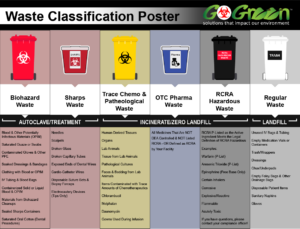
Medical waste is inevitably treated by cremation, autoclaving, microwave, biological, or chemical treatment, regardless of where it is processed. Since the 1990s, as regulations have forced other techniques to come online, incineration, which was formerly by far the most prevalent method, has seen a reduction in use.
What Are The Best Practices When Handling Medical Waste?

Most medical waste concerns can be avoided if healthcare professionals follow a few essential best practices. Employees should be familiar with the rules, and then classify and separate all garbage into the appropriate, color-coded waste bins. Waste should be identified according to its category, and all containers should be accompanied by the appropriate documentation while in transportation. A reputable medical waste disposal firm can assist a hospital in implementing these best practices.
Understand the rules governing the disposal of medical waste. The DOT, EPA, OSHA, and the DEA all control healthcare waste. When preparing, moving, and disposing of hazardous waste, it’s critical to be aware of all regulatory standards.
Correctly classify medical waste. The first step in properly disposing of waste is to identify the type of waste you’re working with. To avoid overspending, do not mix non-hazardous waste with the rest.
Sort the waste into categories. Sharps, pharmaceutical, chemical, pathological, and non-hazardous waste should all be divided into different categories. Medical waste that is regulated is placed in red bags. Sharps must first be placed in puncture-proof containers before being placed in these bags.
Make sure you’re using the proper medical waste containers. Depending on how the waste is categorized, place it in appropriate containers. Some rubbish can be placed in approved cardboard boxes.
Other waste is placed in designated containers or even locked up for transportation.
Make sure the containers are appropriately prepared. Healthcare waste containers and bags must be taped and wrapped according to DOT weight regulations before being sent. Before being picked up or shipped, containers should be stored in a secure, dry location. Prior to transportation, all garbage must be properly labeled.Include any necessary documentation. Both the provider and the waste disposal company benefit from proper recording of healthcare waste. Throughout the process, each container and bag should be accompanied by the appropriate documents.
Use the color code for medical waste disposal. All sharps should be placed in puncture-resistant red biohazard waste containers, according to the color coding scheme for waste segregation. Red bags and containers are used for biohazard waste. Trace chemo waste goes into yellow containers, whereas pharmaceutical waste goes into black containers for hazardous compounds and blue containers for everything else. Radioactive wastes, such as Fluorine-18 or Iodine-131, are placed in radioactively designated shielded containers.
Employ the services of a reputable rubbish removal business. A formidable task for healthcare is dealing with multiple regulatory authorities, varied risks, and diverse types of waste.
Where Is Medical Waste Generated?
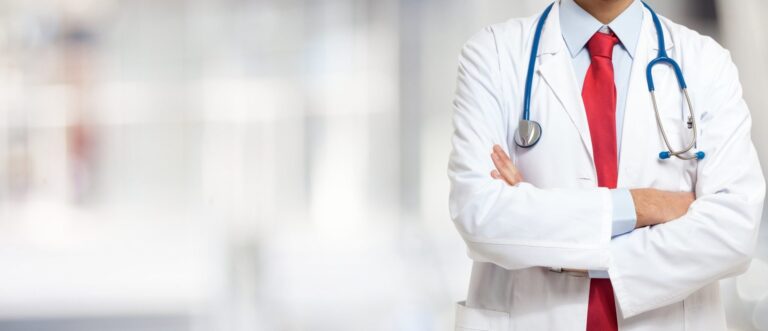
Any medical or biological activity or source can produce medical waste. The prevention, diagnosis, and treatment of several diseases, for example, can all result in hazardous waste.
All caregiver locations, such as private physician clinics and dental offices, as well as veterinary practices, research labs, funeral homes, and anywhere else that satisfies medical needs, are included in the list of waste-generating establishments below.
- Physician Practices/Doctor’s Offices
- Health Clinics
- Dental Offices
- Urgent/Emergency Care Clinics
- Veterinary Practices
- Medical Research Laboratories
- Nursing Homes
- Home Healthcare
- Funeral Homes
- Hospitals
- Commercial Buildings & Offices
What Sets Us Apart From The Other Medical Waste Disposal Companies?
- Access To Electronic Manifests
- Access To All Invoicing History
- Compliance Training Portal
- Safety Plans
- ICD9-ICD10 Conversion
- Plus More!
- Flexible Frequency
- No Hidden Fees or Charges
- No Long Term Contracts
- Cradle to Grave Tracking
- Personal Customer Advocate
- Prompt Service
Additional Resources
The Environmental Protection Agency (EPA) provides a map-based collection of links to state environmental agencies and hazardous waste programs around the United States.
The World Health Organization (WHO) offers a free 308-page manual on the safe management of medical waste, which covers everything from definition and classification through minimization, reuse, collection, and storage.
Local Sharps Disposal
Are you looking for a place to dispose of sharps in your area? Medical waste disposal, including sharps disposal, is provided by Go Green Solutions at a low rate. Quick, dependable, and cost-effective disposal is always close by with our affiliate haulers.
“Providing up to date information to help you stay informed on the latest trends in the industry as well as staying safe and compliant”
For more information, visit the Go Green Blog

Types of Pharmaceutical Waste & How to Dispose of Them
Understanding the Different Types of Pharmaceutical Waste Here are the various categories: These are wastes that are regulated by the U.S. Environmental Protection Agency (EPA)

4 Major Types Of Medical Waste
Medical waste refers to any waste material generated in research activities related to healthcare or during the diagnosis, treatment, or immunization of humans and animals.
Regulated Waste in Dental Practices: What Qualifies as Medical/Hazardous Waste?
One of the most important considerations when running a dental practice is proper medical waste disposal. While it’s essential for the safety of your patients/staff,
